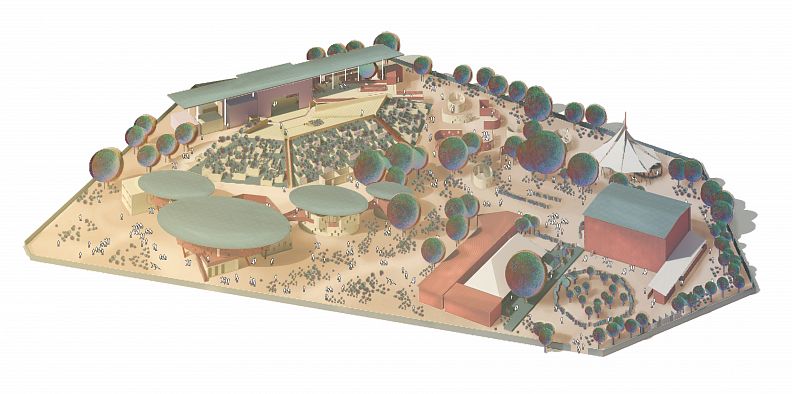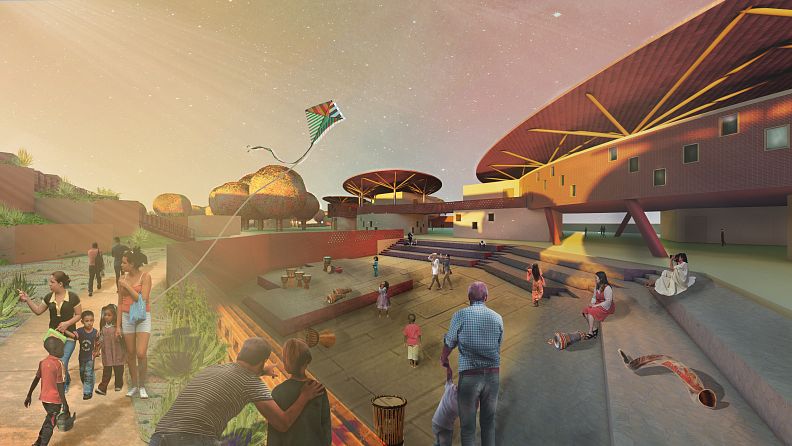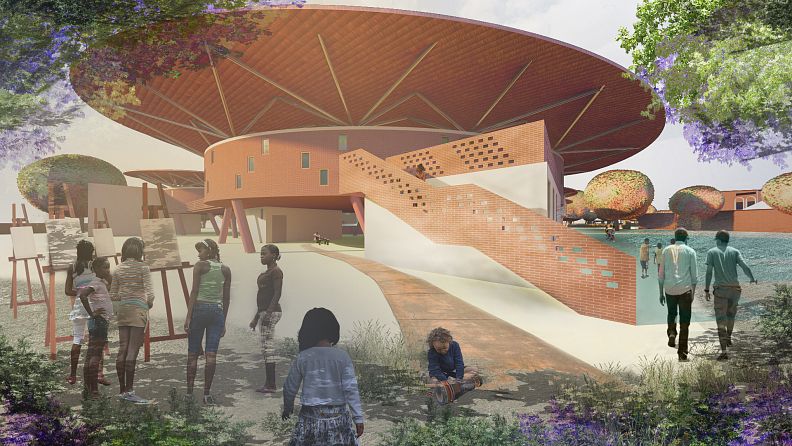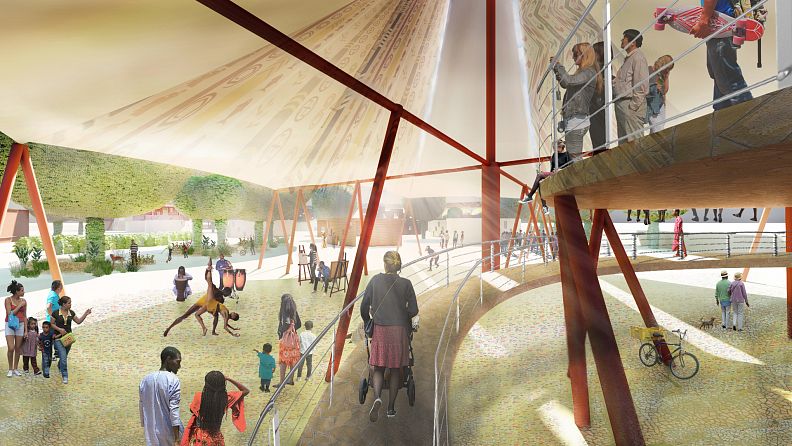'LA TERMITIÉRE' IN THE FOREST

Project idea
Nature has invented such a space as a termite mound. It hosts a vivid community, strong and creative. La Termitiére allows the termites to live comfortably and to pursue their activities, moving through multiple spaces. A similar close community is the CDC, so the project develops a new sophisticated 'mound' environment for the creative community, placed in pure nature.
A termite mound in this case allows us to organize a space, where people feel comfortable and sparkle with creativity. Each 'nest' in the 'mound has flowing life inside, with people engaged in various works. In the neighborhood, under one roof, they inevitably begin to communicate with each other and create close bonds. Social identity of the site is growing, and is manifested through the cultural and social activities, consciousness, responsibility, and freedom of creativity. The space is engaged in a synthesis of Art, bringing people together, from different yet similar backgrounds. It boosts the social, and hence, economic value of the area. Thus, the city canal can once be transformed into a green park area, with La Termitiére as the dominant.
Project description
'Inhabitants' of La Termitiére are located in a comfortable environment. Thanks to the small side windows and covered roof openings, the rooms enjoy a healthy microclimate and the game of daylight. The existing amphitheatre is covered with timber planters, forming the Green Slope as a natural shady shield. The small amphitheatre in the niche is protected from the sun, by the Cultural Centre building's shadow. The air passes through large overhanging roofs with tree-like pillars, creating a pure "forest" hideaway. Elevated passages between the Cultural Centre volumes let the air pass gently and freely, promoting natural ventilation. Like the mound, our centre is constructed from natural building materials. Like a natural form, it is compiled of linear and circular volumes, optimising light reflections and cast shadows. Numerous holes in the railings, walkways, and windows complete the look of the mound.
Folk motifs and ornaments of Burkina Faso are reflected in the rhythms of window openings, perforated railings, and canopy patterns. Simple, collected from primitive shapes, but coming from the soul, they give a unique spiritual image to architecture.
Termites, despite their small size, are able to move a large number of pounds of soil. Similarly, creative people, with their enthusiasm, create art that is many times greater than their own size. Combining such areas as dance, music and theatre, people are able to create something more. To express their ideas and abilities to the world, the existing amphitheatre has been transformed and enlarged by the longitudinal Technical Block, under the elevated roof. The space has a convenient environment for work and leisure, even a garden with an existing tree within the Block. The shaded roof terrace is designed for the staff leisure, as well as for professional exhibitions and other events.
La Termitiére Cultural Centre sparkles creativity of people in the area. This place becomes the point of attraction of the entire area, attracting residents of all ages. Everyone can find entertainment to their liking: while the kids are running around a kind of maze, the older generations can practice dancing in the shade of a large tent. The dominant canopy becomes an advertising landmark, visible from the road. It is the entrance to La Termiére in the Forest.
Technical information
Site plan
1. Main parking area
2. Existing premises
3. Main square for gatherings and performances
4. Landmark dominant area under canopy
5. Open-air labyrinth pavilions for relaxation, ‘in-landscape’ performances and temporary festival events
6. Staff courtyard
7. Open terrace for staff
8. Artistic staff premises under the elevated roof
9. Transformable two-sided stage
10. Technical staff premises under the elevated roof
11. Backstage yard
12. Technical access with indoor and outdoor parking
13. Existing amphitheatre
14. Green slope with timber planters
15. Side alleys
16. Gathering square
17. Ground-level niche with a mini-stage and an amphitheatre
18. New ‘Termitiére’ Cultural Centre
19. Cultural Centre yards
20. Park alleys with archways under Cultural Centre galleries
21. Activity ground
Cultural Centre Layout
Ground floor
1. Restaurant storage, technical and staff rooms
2. Archive
3. Photo studio with storage
4. Co-working with meeting spaces
5. Modular media-rooms block
6. Audio-recording studio with storage
7. Open-air stage
Second floor
8. Restaurant kitchen
9. Restaurant hall
10. Gallery
11. Transformable Grand educational space for theatre
12. Educational studio for puppet theatre
13. Dance studio wit changing rooms
14. Music studios with storage and a rehearsal room
15. Video-making studio with storage
Technical Block Layout
Ground floor
1. 20 dressing rooms for actors
2. Open-air meeting hall
3. Garden with an existing tree
4. Separated WC and showers with changing rooms
5. Sewing workshop with an atelier, workzone, storage, and washing+ironing zone
6. Transformable two-sided stage with a variable depth
7. Decorations storage
8. Technical workshop
9. Repair and equipment space
10. Administration
11. Trucks and cars garage with a technician’s room
Second floor
12. Stage technical galleries
13. Technical cabin
14. Technical workshop
15. Multi-purpose open terrace for staff, under the elevated roof
16. Kitchenette
Co-authors
The project team includes Anna Guseva, Vladislav Krayushkin, Adelina Gazizyanova, Yana Vanyushina.
The tutors, guiding the project, are Ilnar Akhtiamov and Rezeda Akhtiamova.
















